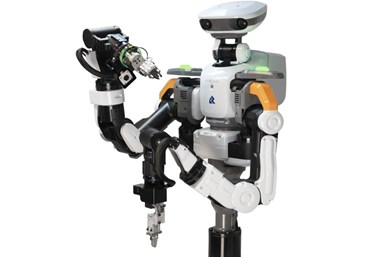Humanoid Robot Features User-Friendly Control Interface
IMTS 2022: Rollomatic offers the Kawada humanoid industruil robot, compatible with conventional industrial robots.
Share





Rollomatic Inc.’s Kawada humanoid, industrial robot is a handling system intended to meet increasing demands in the areas of IIoT and the smart factory.
The robot autonomously performs tasks such as cassette loading, pregrinding or post‐grinding tool inspection, laser marking, placing finished products into packaging tubes and affixing labels to the tubes.
This is type of industrial robot is able to perform tasks in locations that are difficult for traditional robots to access because of its frame and size. It is said it can be installed with ease without the need to redesign production lines.
The company says this efficient, humanoid robot was designed to be seamlessly placed where a person usually operates, and use its head and two arms (equipped with cameras) to take over tedious, dangerous or repetitive tasks, enabling workers to focus on areas that require creativity and generate greater added value.
Users can control and teach Nextage what to do with a visual and user‐friendly interface. Nextage was also designed to be compatible with conventional industrial robots or other specialized equipment, enabling the possibility for a team framework.
A stand‐alone cassette loading station is available utilizing the Kawada humanoid robot. This station loads cutting tool blanks into Rollomatic cassettes from two different types of feeders — a V‐type feeder magazine and a vibratory bowl feeder.
Related Content
-
4 Steps to a Cobot Culture: How Thyssenkrupp Bilstein Has Answered Staffing Shortages With Economical Automation
Safe, economical automation using collaborative robots can transform a manufacturing facility and overcome staffing shortfalls, but it takes additional investment and a systemized approach to automation in order to realize this change.
-
Lean Approach to Automated Machine Tending Delivers Quicker Paths to Success
Almost any shop can automate at least some of its production, even in low-volume, high-mix applications. The key to getting started is finding the simplest solutions that fit your requirements. It helps to work with an automation partner that understands your needs.
-
Translating a Prototyping Mindset to Production
The experimental mindset that benefited BDE Manufacturing Technologies as a prototype job shop has given it an adaptable edge as a production facility.





















.png;maxWidth=300;quality=90)


